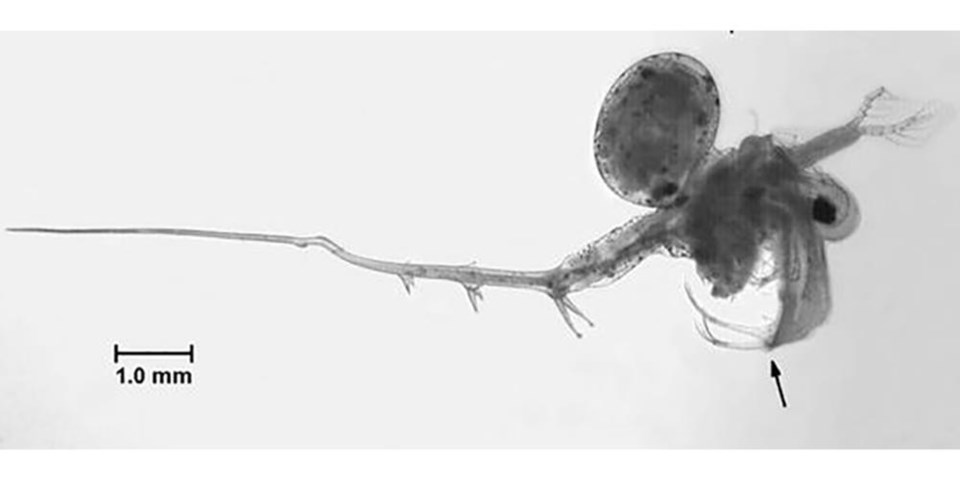It looks like something out of Alien.
Big eyes, grasping arms, round egg sac, and a long spike of a tail with wicked-looking barbs.
Fortunately, the spiny water flea is only 12-15 millimetres long. It’s not even a flea — it’s a type of zooplankton, the free-swimming miniscule animal life found in most water bodies.
Unfortunately, the spiny water flea (Latin name Bythotrephes longimanus) isn’t supposed to be found in North American water bodies. It was introduced from Northern Europe and Asia, presumably in the ballast water of ships.
First showing up in Lake Ontario in the 1980s, spiny water flea has proven to be a quickly-reproducing, voracious predator.
“It eats other zooplankton, like Daphnia,” said Lake Simcoe Region Conservation Authority limnologist Brian Ginn. “It reduces the food for other things that eat zooplankton,” such as young fish.
And with its long spine, “it’s kind of hard to swallow and digest.”
Spiny water flea showed up in Lake Simcoe in 1993. Its arrival coincided with a 30- to 40 per-cent decline in the occurrence of native zooplankton, according to Ginn.
But since then, numbers seem to have stabilized, and are lower than in the other Great Lakes.
Ginn thinks the difference may be a result of the larger herring, cisco and even black crappie fish populations in Lake Simcoe, all of which feed on spiny water flea.
“It’s now in balance,” he said, although its long-term impact on fish populations is still being studied.
Not only is the nutritional value of spiny water flea a question mark, the zooplankton is known to be hard to digest.
“It sticks in the throat and clogs up the digestive system” of fish, Ginn noted.
Management of the species at this point is a matter of monitoring.
“Once it is in the lake, you can’t get it out,” Ginn said.
The focus becomes preventing the spread of invasives like spiny water flea, and the related fish-hook water flea, which has a curved hook instead of a straight spine, and has been found in Lakes Ontario and Erie.
As with other invasive species, the path of spread seems to be through boaters and anglers, who may carry spiny water flea in their bilge and bait bucket water.
The zooplankton poses another problem: it tends to clump on fishing lines, cables and other equipment, requiring power-washing to remove the clinging water flea.
“You’ve got to ‘Clean, Drain and Dry’” before moving boats from one water body to another, Ginn said. “Unfortunately, people don’t seem to be getting the message.”
There are now reports of spiny water flea in some Muskoka lakes.



